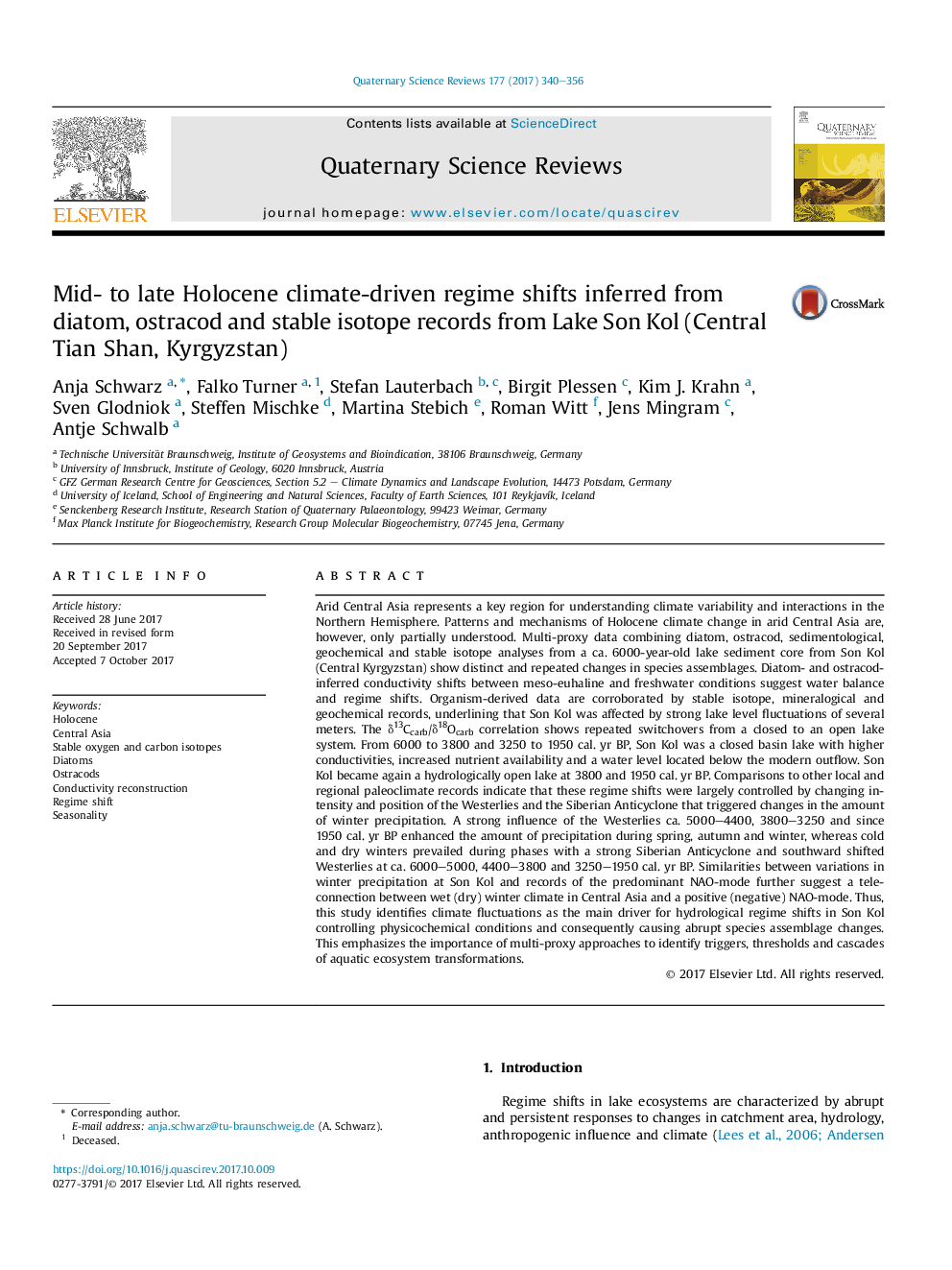| کد مقاله | کد نشریه | سال انتشار | مقاله انگلیسی | نسخه تمام متن |
|---|---|---|---|---|
| 8915110 | 1640758 | 2017 | 17 صفحه PDF | دانلود رایگان |
عنوان انگلیسی مقاله ISI
Mid- to late Holocene climate-driven regime shifts inferred from diatom, ostracod and stable isotope records from Lake Son Kol (Central Tian Shan, Kyrgyzstan)
دانلود مقاله + سفارش ترجمه
دانلود مقاله ISI انگلیسی
رایگان برای ایرانیان
کلمات کلیدی
موضوعات مرتبط
مهندسی و علوم پایه
علوم زمین و سیارات
زمین شناسی
پیش نمایش صفحه اول مقاله

چکیده انگلیسی
Arid Central Asia represents a key region for understanding climate variability and interactions in the Northern Hemisphere. Patterns and mechanisms of Holocene climate change in arid Central Asia are, however, only partially understood. Multi-proxy data combining diatom, ostracod, sedimentological, geochemical and stable isotope analyses from a ca. 6000-year-old lake sediment core from Son Kol (Central Kyrgyzstan) show distinct and repeated changes in species assemblages. Diatom- and ostracod-inferred conductivity shifts between meso-euhaline and freshwater conditions suggest water balance and regime shifts. Organism-derived data are corroborated by stable isotope, mineralogical and geochemical records, underlining that Son Kol was affected by strong lake level fluctuations of several meters. The δ13Ccarb/δ18Ocarb correlation shows repeated switchovers from a closed to an open lake system. From 6000 to 3800 and 3250 to 1950 cal. yr BP, Son Kol was a closed basin lake with higher conductivities, increased nutrient availability and a water level located below the modern outflow. Son Kol became again a hydrologically open lake at 3800 and 1950 cal. yr BP. Comparisons to other local and regional paleoclimate records indicate that these regime shifts were largely controlled by changing intensity and position of the Westerlies and the Siberian Anticyclone that triggered changes in the amount of winter precipitation. A strong influence of the Westerlies ca. 5000-4400, 3800-3250 and since 1950 cal. yr BP enhanced the amount of precipitation during spring, autumn and winter, whereas cold and dry winters prevailed during phases with a strong Siberian Anticyclone and southward shifted Westerlies at ca. 6000-5000, 4400-3800 and 3250-1950 cal. yr BP. Similarities between variations in winter precipitation at Son Kol and records of the predominant NAO-mode further suggest a teleconnection between wet (dry) winter climate in Central Asia and a positive (negative) NAO-mode. Thus, this study identifies climate fluctuations as the main driver for hydrological regime shifts in Son Kol controlling physicochemical conditions and consequently causing abrupt species assemblage changes. This emphasizes the importance of multi-proxy approaches to identify triggers, thresholds and cascades of aquatic ecosystem transformations.
ناشر
Database: Elsevier - ScienceDirect (ساینس دایرکت)
Journal: Quaternary Science Reviews - Volume 177, 1 December 2017, Pages 340-356
Journal: Quaternary Science Reviews - Volume 177, 1 December 2017, Pages 340-356
نویسندگان
Anja Schwarz, Falko Turner, Stefan Lauterbach, Birgit Plessen, Kim J. Krahn, Sven Glodniok, Steffen Mischke, Martina Stebich, Roman Witt, Jens Mingram, Antje Schwalb,